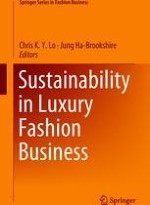2018 | OriginalPaper | Chapter
3. The Marketing of Sustainability and CSR Initiatives by Luxury Brands: Cultural Indicators, Call to Action, and Framework
Author : RayeCarol Cavender
Published in: Sustainability in Luxury Fashion Business
Publisher: Springer Singapore
Activate our intelligent search to find suitable subject content or patents.
Select sections of text to find matching patents with Artificial Intelligence. powered by
Select sections of text to find additional relevant content using AI-assisted search. powered by
